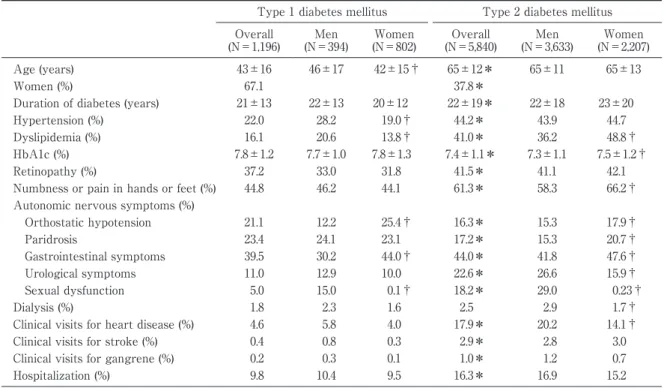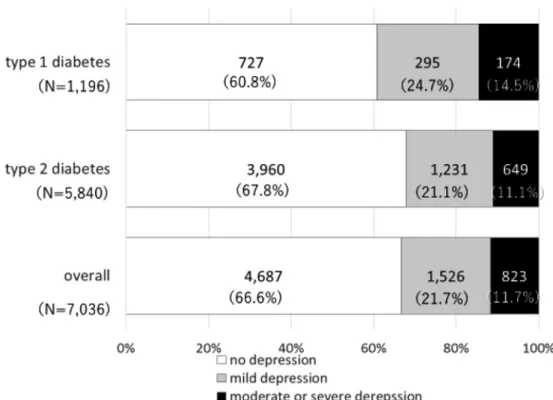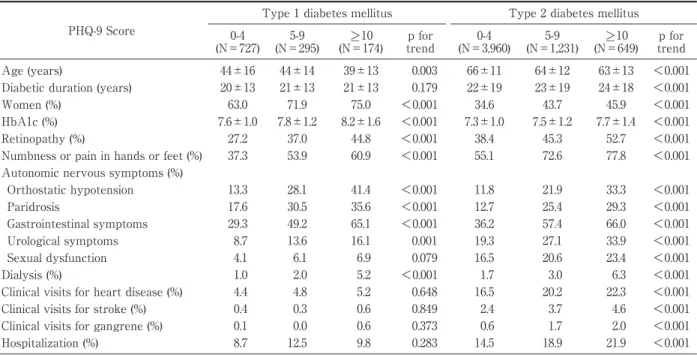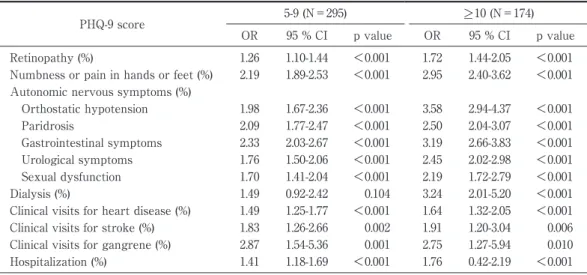原 著
糖尿病とうつ病との関連に関する横断研究
―糖尿病診療の実態に関する前向き調査(DIACET)を用いた解析―
東京女子医科大学糖尿病センター(糖尿病・代謝内科) イシザワ カ ヤ バ バ ゾ ノ テ ツ ヤ ホ リ バ ユウ ナカジマ ジュンコ 石澤 香野・馬場園哲也・堀場 悠・中嶋 順子 タカサキ ケ イ コ ミ ウ ラ ジュンノスケ ウチガタ ヤ ス コ 高崎 圭子・三浦順之助・内潟 安子 (受理 平成 29 年 3 月 17 日)The Relationship between Diabetes Mellitus and Depression: Analysis Using the Diabetes Study from the Center of Tokyo Women s Medical University (DIACET)
Kaya ISHIZAWA, Tetsuya BABAZONO, Yu HORIBA, Junko NAKAJIMA, Keiko TAKASAKI, Junnosuke MIURA and Yasuko UCHIGATA
Diabetes Center, Tokyo Women s Medical University School of Medicine
Objective: To investigate the incidence and severity of depression, and its association with diabetic
complica-tions, among Japanese patients with type 1 and type 2 diabetes.
Methods: This was a single-center cross-sectional study, performed as a part of the Diabetes Study from the
Center of Tokyo Women s Medical University (DIACET), established in 2012 by the DIACET committee. All sub-jects received self-administered questionnaires which included questions regarding the diabetic condition, subjec-tive symptoms associated with diabetic micro- and macroangiopathy, frequency of clinical visits due to vascular diseases, and the Patient Health Questionnaire-9 (PHQ-9), a measure of depression. We extracted data for patients with type 1 and type 2 diabetes. The incidence and severity of depression in patients with type 1 and type 2 dia-betes, and the associations between the severity of depression and diabetic complications were examined using logistic regression analysis.
Results: A total of 7,036 patients with type 1 and type 2 diabetes were studied. The mean (±SD) age was 61
±15 years, 1,196 patients had type 1 diabetes, and 3,009 patients were women. According to the PHQ-9 scores, pa-tients were classified into the following 3 categories: 0-4 points, no depression (n=4,687); 5-9 points, mild depression (n=2,349); and 10 or more points, moderate or severe depression (n=823). Accordingly, 2,349 patients (33.4 %) of the patients with diabetes had depressive symptoms as indicated by a PHQ-9 score of 5 or more. Although fre-quency of depressive symptoms were significantly greater among patients with type 1 diabetes, the significance disappeared after adjustment for age and gender using multiple logistic regression analysis, yielding odds ratio (OR) of mild depression=0.94, 95 % confidence interval (CI)=0.78-1.12 (p=0.482) and OR of moderate or severe de-pression=0.89, 95 %CI=0.71-1.11 (p=0.293). Higher PHQ-9 scores were associated with increased ORs for retinopa-thy, neuroparetinopa-thy, and end-stage kidney disease requiring dialysis after adjustment for age, gender, and HbA1c in both type 1 and type 2 diabetes patients (p<0.001).
Conclusion: There were no differences in likelihood or severity of depression between type 1 and type 2
dia-betes. Significant relationships were found between depression severity and chronic diabetic complications among patients with both type 1 and type 2 diabetes.
Key Words: depression, type of diabetes, microangiopathy, macroangiopathy, PHQ-9
:石澤香野 〒162―8666 東京都新宿区河田町 8―1 東京女子医科大学糖尿病センター Email: ishizawa.dmc@twmu.ac.jp
doi: 10.24488/jtwmu.87.Extra2_E198
Copyright Ⓒ 2017 Society of Tokyo Women s Medical University
! # $ 東女医大誌 第 87 巻 臨時増刊 2 号 頁 E198∼E206 平成 29 年11月 " # %
緒 言 糖尿病とうつ病との間には密接な関連がある.こ れまでの欧米からの報告によると,うつ病の疑いが ある糖尿病患者は約 25∼30 %前後にのぼるとされ ており1)∼4) ,その頻度は一般人口の約 2 倍と高率であ る1) .糖尿病とうつ病の発症機序は双方向的とされ る.うつ病患者でみられる過食など食行動の変化や 身体活動の減少,間脳視床下部・下垂体・副腎皮質 系および交感神経系の亢進,さらには炎症性サイト カインの増加が,糖尿病の発症や血糖コントロール の悪化の要因となりうる5) .一方糖尿病患者では,食 事療法や運動療法に伴うライフスタイルの変更,自 己注射や自己血糖測定などのセルフケア,さらには 糖尿病合併症に伴う身体機能の制限などが精神的負 担となり,うつの要因となる可能性が指摘されてい る6) . 1 型糖尿病と 2 型糖尿病ではその病態が大きく異 なることから,うつ病との関連においても両病型間 で異なる可能性がある.しかしこれまでの報告では, 一定の見解が得られていない1)7) .既に我々は,2012 年 10 月に当施設で開始した,「糖尿病診療の実態を
調査する前向き研究(Diabetes Study from the Cen-ter of Tokyo Women s Medical University : DI-ACET)」の初回調査に参加した 65 歳以上の高齢糖 尿病患者 4,283 名を対象とし,うつの頻度および糖 尿病合併症との関連を報告した8) .この解析では,1 型糖尿病の 34.7 %,2 型糖尿病の 30.4 %がうつ症状 を合併していたが,病型間の差は有意でなかった. ただし高齢患者のみを対象としたことから 1 型糖尿 病患者が 167 名(3.9 %)とわずかであり,糖尿病型 別の比較を行うにはより多くの 1 型糖尿病患者を含 む 検 討 が 必 要 と 考 え ら れ た.そ こ で 本 研 究 は, DIACET に参加したすべての年齢層の糖尿病患者 を対象として,うつの頻度および糖尿病合併症との 関連を解析し,特に 1 型糖尿病と 2 型糖尿病のうつ との関連を比較検討することを目的とした. 対象と方法 1.対象 本研究では,2012∼2013 年に上記 DIACET に参 加し,Patient Health Questionnaire(PHQ)-99)
の全質 問に回答した日本人 1 型および 2 型糖尿病患者を対 象とした.参加者の糖尿病罹患の有無,および糖尿 病型は診療録の閲覧により確認し,本研究では正常 耐糖能,境界型,その他の糖尿病は除外した. 2.方法 DIACET は,既報の通り8) ,定期外来受診時あるい は入院時に自己記入式の質問票を配布し,外来患者 では次回の外来受診日あるいは郵送で,入院患者で は入院中に調査票を回収した.なお小児患者で自己 記入困難な場合には,保護者が代わって回答するこ ととした.質問票には,血糖管理・治療状況,糖尿 病合併症および合併症に伴う自覚症状などに加え, 後述の PHQ-99) を用いてうつ症状の有無とその重症 度を評価した.糖尿病合併症については,糖尿病網 膜症,糖尿病神経障害に伴うしびれ・痛み,自律神 経障害に伴う起立性低血圧,発汗障害,消化器症状, 泌尿器症状,性機能障害,さらには透析治療の有無 について調査した.さらに,心疾患,脳卒中,足壊 疽による受診頻度,過去 1 年間の血糖コントロール, および癌など他疾患による入院も含めたすべての入 院の頻度を調査した. PHQ-9 は,自己調査票により過去 2 週間の 9 つの うつ症状の頻度を問うもので,それらが「全くない」, 「数日」,「半分以上」,「ほとんど毎日」をそれぞれ 0∼ 3 点にスコア化した上で,その合計得点(0∼27 点) を算出する9) .その日本語版の信頼性,妥当性は,す でに Muramatsu らによって評価されてい る10) .9 項目の合計得点 5 点以上が軽度のうつ症状,10 点以 上が中等度から重度のうつ症状と定義されている. なお 10 点以上では,大うつ病の感度,特異度がいず れも 88 %であると報告されている9) .本研究では,0-4 点のうつなし,5-9 点の軽症うつ,10 点以上の中等 度以上のうつ症状の 3 段階に分類した. HbA1c は, DIACET の調査票配布前後 90 日間に測定された データを用いた. 本研究は東京女子医科大学の倫理委員会で承認さ れ(承認番号 2481-R),参加者のインフォームド・コ ンセントを得て施行された. 3.統計解析 糖尿病型による 2 群間の臨床所見の比較,および 同じ糖尿病型内における男女間の臨床所見の比較は Student s t test および Wilcoxon sum-rank test で 行った.糖尿病型によるうつの頻度の差の検討は, 年齢と性別で補正したロジスティック回帰分析を用 いて解析した.うつの重症度によって分類した 3 群 間の比較は Jonckheere-Terpstra 傾向性検定あるい は Cochran-Armitage 傾向性検定を用いた.さらに, う つ の 重 症 度 と 合 併 症 と の 関 連 を,罹 病 期 間 や HbA1c を含む背景因子で調整した多 変 量 ロ ジ ス
Table 1 Clinical characteristics and diabetic complications in men and women with type 1 and type 2 diabe-tes mellitus
Type 1 diabetes mellitus Type 2 diabetes mellitus Overall (N=1,196) Men (N=394) Women (N=802) Overall (N=5,840) Men (N=3,633) Women (N=2,207) Age (years) 43±16 46±17 42±15† 65±12* 65±11 65±13 Women (%) 67.1 37.8*
Duration of diabetes (years) 21±13 22±13 20±12 22±19* 22±18 23±20 Hypertension (%) 22.0 28.2 19.0† 44.2* 43.9 44.7 Dyslipidemia (%) 16.1 20.6 13.8† 41.0* 36.2 48.8† HbA1c (%) 7.8±1.2 7.7±1.0 7.8±1.3 7.4±1.1* 7.3±1.1 7.5±1.2† Retinopathy (%) 37.2 33.0 31.8 41.5* 41.1 42.1 Numbness or pain in hands or feet (%) 44.8 46.2 44.1 61.3* 58.3 66.2† Autonomic nervous symptoms (%)
Orthostatic hypotension 21.1 12.2 25.4† 16.3* 15.3 17.9† Paridrosis 23.4 24.1 23.1 17.2* 15.3 20.7† Gastrointestinal symptoms 39.5 30.2 44.0† 44.0* 41.8 47.6† Urological symptoms 11.0 12.9 10.0 22.6* 26.6 15.9† Sexual dysfunction 5.0 15.0 0.1† 18.2* 29.0 0.23† Dialysis (%) 1.8 2.3 1.6 2.5 2.9 1.7† Clinical visits for heart disease (%) 4.6 5.8 4.0 17.9* 20.2 14.1† Clinical visits for stroke (%) 0.4 0.8 0.3 2.9* 2.8 3.0 Clinical visits for gangrene (%) 0.2 0.3 0.1 1.0* 1.2 0.7 Hospitalization (%) 9.8 10.4 9.5 16.3* 16.9 15.2 Data are given as means±SD or percent. *p<0.05 comparing patients with type 1 vs. type2 diabetes, †p<0.05 com-paring men and women within the same type of diabetes using Student s t test and Wilcoxon sum-rank test.
PHQ-9, Patient Health Questionnaire-9; HbA1c, hemoglobin A1c.
ティック回帰分析を用いて解析した.以上の統計解 析はすべて SAS/STAT version 14.1(SAS institute, Cary, NC,USA)を用いて行い,p<0.05 を有意とし た. 結 果 1.対象患者の臨床所見 対象となった糖尿病患者は 7,036 名であり,平均 年齢は 61±15(標準偏差)歳(3∼96 歳),性別は女 性 3,009 名,男 性 4,027 名,糖 尿 病 型 は 1 型 1,196 名,2 型 5,840 名であった.対象患者の病型および性 別の臨床背景は Table 1 に示す通りである.糖尿病 型による比較では,2 型糖尿病患者に比して 1 型糖 尿病患者がより若年であり(p<0.01),1 型糖尿病患 者で女性が有意に多かった(p<0.01).2 型糖尿病患 者で高血圧や脂質異常症の合併が多く,細小血管障 害(神経障害や網膜症)および大血管障害(心疾患, 脳卒中,足壊疽に伴う受診)の合併頻度,さらには 過去 1 年間の入院頻度も高かった.男女別の比較で は,両病型とも女性で性機能障害を除く自律神経障 害に伴う自覚症状が多く,2 型糖尿病男性で透析お よび心疾患の合併が高率であった. 2.糖尿病患者におけるうつ状態の合併率 全対象患者の,4,687 名(66.6 %)がうつなし(PHQ-9 スコア 0-4 点),1,526 名(21.7 %)が軽症うつ(同 5-9 点),823 名(11.7 %)が 10 点以上の中等度以上 のうつ状態に該当した(Fig. 1). 糖尿病型によるうつ状態の合併および重症度は Fig. 1 に示すように,1 型糖尿病患者でよりうつが多 く,重 症 の 傾 向 で あ っ た(p<0.001,Cochran-Armitage 傾向性検定).男女毎のうつ状態の比較で は,両病型ともに,女性で男性よりもうつ状態の合 併が高率であった(Fig. 2).年齢と性別で補正したロ ジスティック回帰分析を行ったところ,2 型糖尿病 に対する 1 型糖尿病の軽症うつおよび中等度以上の うつ合併オッズ比(95 %信頼区間)はそれぞれ 0.94 (0.78-1.12,p=0.482)および 0.89(0.71-1.11,p=0.293) であり,1 型糖尿病患者におけるうつ合併リスク増 加の有意性は消失した(Table 2). 3.うつと糖尿病合併症の関連 うつの重症度と臨床背景および糖尿病合併症との 関連を Table 3 に示す.1 型,2 型糖尿病ともに,う つが重症であるほど若年者および女性が多くなる傾 向を認めた.また 2 型糖尿病患者では,うつが重症
Fig. 1 Prevalence and severity of depression according to the type of diabetes. The white bars indicate the number and proportion of patients with total PHQ-9 scores of 0-4 points (no depression), the gray bars indicate those with 5-9 points (mild depression), and the black bars indicate those with 10 points or more (moderate or severe depression) in the top, middle, and bottom panels for type 1 diabetes patients, type 2 diabetes patients, and overall patients, respectively. PHQ-9, Patient Health Questionnaire-9.
であるほど罹病期間が長い傾向を,血糖コントロー ルの指標である HbA1c は,両病型ともうつがより 重症の患者で高値の傾向を認めた.1 型糖尿病患者 では,うつの重症度と関連して,細小血管障害であ る糖尿病網膜症,神経障害に伴うしびれ・痛み,自 律神経障害(起立性低血圧,発汗障害,消化器症状, 泌尿器症状,性機能障害),および透析施行中の末期 糖尿病性腎症が増加する傾向を認めた.2 型糖尿病 患者では,上記に加えて,大血管障害(心疾患,脳 卒中,足壊疽)による通院頻度,過去 1 年間の入院 率が増加する傾向を認めた. 多変量ロジスティック回帰分析(Table 4,5)で は,両病型ともに,うつの重症度に伴って,糖尿病 の細小血管障害である網膜症,神経障害,末期糖尿 病性腎症のオッズ比が有意に上昇した. 4.うつと過去 1 年間の入院との関連 入院の有無に対する多変量ロジスティック回帰分 析では,2 型糖尿病患者でのみ,うつの重症度に伴っ て,過去 1 年間の入院オッズ比が有意に上昇した (Table 5). 考 察 本研究は,糖尿病患者におけるうつの頻度および 糖尿病合併症との関連を 1 型および 2 型糖尿病型間 で比較することを目的とした.まず全対象患者,す なわち 1 型 1,196 名および 2 型糖尿病患者 5,840 名, 計 7,036 名のうち,2,349 名(33.4 %)で PHQ-9 スコ ア 5 点以上のうつ状態を合併しており,さらに 823 名(11.7 %)が同スコア 10 点以上の中等度以上のう つ状態に該当した.また女性でうつの頻度が有意に 高く,より重症の傾向であった.これらの結果は既 報1)2)4)9) とほぼ一致した.糖尿病型別の比較では,1 型糖尿病でうつの頻度が有意に多かったが,これは 2 型糖尿病の方がうつが有意に多いとする Pouwer らの報告7) と異なる結果であった.本研究での 1 型お よび 2 型糖尿病患者の年齢は Pouwer らの報告7) と ほぼ同様であったが,本研究では 1 型糖尿病のなか で女性が占める割合が 67.1 %と有意に多く,この偏 りが両者の結果の差を生じた可能性があった.そこ で糖尿病型によるうつの頻度を,年齢と性別で補正 したロジスティック回帰分析を用いて比較したとこ ろ,うつ状態の合併率は,病型間で差がなくなった.
Table 2 Risk of depressive symptoms of type of diabetes PHQ-9 score 5-9 (N=295) >_ 10 (N=174) OR 95 % CI p value OR 95 % CI p value Age 0.99 0.9-0.996 <0.001 0.99 0.981-0.992 <0.001 Gender 1.35 1.20-1.52 <0.001 1.47 1.26-1.71 <0.001 Type of diabetes
(type 1 versus type 2 diabetes)
0.94 0.78-1.12 0.482 0.89 0.71-1.11 0.293
Data were analyzed using a logistic regression model adjusting for age, sex. PHQ-9, Patient Health Questionnaire-9; OR, odds ratio.
Fig. 2 Prevalence and severity of depression according to type of diabetes and gender. The white bar shows both the number and proportion of participants with total PHQ-9 scores of 0-4 points (no depression), the gray bar shows those with 5-PHQ-9 points (mild depression), and the black bar shows those with 10 points or more (moderate or severe depression) in type 1 diabetes women and men, and type 2 diabetes women and men, respectively. PHQ-9, Patient Health Questionnaire-9.
これは過去のシステマティックレビュー1) と同様の 結果であり,本研究で対象とした日本人糖尿病患者 においても,糖尿病型間のうつ合併率に差はないこ とが示唆された. 糖尿病は長期罹病期間のなかで,さまざまな慢性 合併症を生じ得る.糖尿病の限局した症状(多尿, 空腹感,口渇など)11) や心血管障害とうつとの関連4) が指摘される一方で,糖尿病の細小血管障害とうつ 症状との関連は,これまで明らかでなかった.また Pouwer らは,1 型糖尿病でうつと糖尿病網膜症が関 連する一方,2 型糖尿病では神経障害が関連したと 報告しており7) ,糖尿病型によってうつと糖尿病合併 症の関連が異なる可能性が指摘されていた.既に 我々は,65 歳以上の高齢糖尿病患者において,細小 血管障害である神経障害,網膜症,さらには透析療 法に至る末期糖尿病性腎症が,大血管障害とともに うつの重症度と関連することを報告した8) .今回解析 対象を若年者も含む 7,036 名として,病型ごとに細 小血管障害・大血管障害とうつの重症度との関連を 検討したところ,1 型,2 型糖尿病患者ともに,臨床 背景で補正後も,うつの重症度と細小血管障害であ る神経障害,網膜症,末期糖尿病性腎症の合併が有
Table 3 Comparison of baseline characteristics and diabetic complications among type 1 and type 2 diabetic pa-tients classified according to PHQ-9 score
PHQ-9 Score
Type 1 diabetes mellitus Type 2 diabetes mellitus 0-4 (N=727) 5-9 (N=295) >_ 10 (N=174) p for trend 0-4 (N=3,960) 5-9 (N=1,231) >_ 10 (N=649) p for trend Age (years) 44±16 44±14 39±13 0.003 66±11 64±12 63±13 <0.001 Diabetic duration (years) 20±13 21±13 21±13 0.179 22±19 23±19 24±18 <0.001 Women (%) 63.0 71.9 75.0 <0.001 34.6 43.7 45.9 <0.001 HbA1c (%) 7.6±1.0 7.8±1.2 8.2±1.6 <0.001 7.3±1.0 7.5±1.2 7.7±1.4 <0.001 Retinopathy (%) 27.2 37.0 44.8 <0.001 38.4 45.3 52.7 <0.001 Numbness or pain in hands or feet (%) 37.3 53.9 60.9 <0.001 55.1 72.6 77.8 <0.001 Autonomic nervous symptoms (%)
Orthostatic hypotension 13.3 28.1 41.4 <0.001 11.8 21.9 33.3 <0.001 Paridrosis 17.6 30.5 35.6 <0.001 12.7 25.4 29.3 <0.001 Gastrointestinal symptoms 29.3 49.2 65.1 <0.001 36.2 57.4 66.0 <0.001 Urological symptoms 8.7 13.6 16.1 0.001 19.3 27.1 33.9 <0.001 Sexual dysfunction 4.1 6.1 6.9 0.079 16.5 20.6 23.4 <0.001 Dialysis (%) 1.0 2.0 5.2 <0.001 1.7 3.0 6.3 <0.001 Clinical visits for heart disease (%) 4.4 4.8 5.2 0.648 16.5 20.2 22.3 <0.001 Clinical visits for stroke (%) 0.4 0.3 0.6 0.849 2.4 3.7 4.6 <0.001 Clinical visits for gangrene (%) 0.1 0.0 0.6 0.373 0.6 1.7 2.0 <0.001 Hospitalization (%) 8.7 12.5 9.8 0.283 14.5 18.9 21.9 <0.001 Data are given as means±SD or percent. Trends in the mean age, duration and HbA1c were determined using Jonckheere-Terpstra trend test and those in frequency using Cochran-Armitage trend test.
PHQ-9, Patient Health Questionnaire-9; HbA1c, hemoglobin A1c.
Table 4 Risk of symptoms and conditions associated with diabetic chronic complications in type 1 diabetic patients with PHQ-9 scores of 5-9 and >_10 compared to PHQ-9 scores of 0-4
PHQ-9 score 5-9 (N=295) >_ 10 (N=174) OR 95 % CI p value OR 95 % CI p value Retinopathy (%) 1.56 1.14-2.13 <0.001 2.30 1.58-3.40 <0.001 Numbness or pain in hands or feet (%) 2.08 1.54-2.82 <0.001 3.30 2.25-4.86 <0.001 Autonomic nervous symptoms (%)
Orthostatic hypotension 2.07 1.49-2.88 <0.001 2.92 1.97-4.32 <0.001 Paridrosis 2.07 1.49-2.88 <0.001 2.92 1.97-4.32 <0.001 Gastrointestinal symptoms 2.14 1.60-2.87 <0.001 4.56 3.12-6.67 <0.001 Urological symptoms 1.64 1.04-2.58 <0.001 2.51 1.47-4.28 <0.001 Sexual dysfunction 2.05 1.04-4.02 0.03 3.44 1.48-8.03 <0.001 Dialysis (%) 2.22 0.74-6.72 0.157 6.43 2.20-18.76 <0.001 Clinical visits for heart disease (%) 1.21 0.60-2.44 0.593 2.22 0.96-5.15 0.063 Clinical visits for stroke (%) 0.92 0.09-9.54 0.945 2.68 0.24-30.0 0.424 Clinical visits for gangrene (%) ― ― 5.28 0.31-90.0 0.254 Hospitalization (%) 1.53 0.98-2.39 0.06 1.38 0.77-2.48 0.284 Data were analyzed using a logistic regression model adjusting for age, sex, and HbA1c levels. Participants with PHQ-9 score of 0-4 (N=2,825) was the reference group. In all models, OR was statistically significant (p <0.05).
PHQ-9, Patient Health Questionnaire-9; HbA1c, hemoglobin A1c; OR, odds ratio.
意に関連した.さらに 2 型糖尿病患者では,大血管 障害や過去 1 年間の入院頻度がうつの重症度と関連 した.うつが重症であるほど糖尿病合併症がいずれ も深刻であることが示唆され,糖尿病患者において, 病型を問わずうつが臨床上重要な問題であることが 示された. 本研究は横断研究であり,うつの重症度と糖尿病 合併症との因果関係は不明である.しかしこれまで に,網膜症による視力障害12) や慢性腎臓病における 透析導入13) ,糖尿病性神経障害14) などがうつの発症に 関連することが報告されており,糖尿病の多彩な慢 性合併症が患者の精神的負担となり,うつ状態と関
Table 5 Risk of symptoms and conditions associated with diabetic chronic complications in type 2 diabetic patients with PHQ-9 scores of 5-9 and >_ 10 compared to PHQ-9 scores of 0-4
PHQ-9 score 5-9 (N=295) >_ 10 (N=174) OR 95 % CI p value OR 95 % CI p value Retinopathy (%) 1.26 1.10-1.44 <0.001 1.72 1.44-2.05 <0.001 Numbness or pain in hands or feet (%) 2.19 1.89-2.53 <0.001 2.95 2.40-3.62 <0.001 Autonomic nervous symptoms (%)
Orthostatic hypotension 1.98 1.67-2.36 <0.001 3.58 2.94-4.37 <0.001 Paridrosis 2.09 1.77-2.47 <0.001 2.50 2.04-3.07 <0.001 Gastrointestinal symptoms 2.33 2.03-2.67 <0.001 3.19 2.66-3.83 <0.001 Urological symptoms 1.76 1.50-2.06 <0.001 2.45 2.02-2.98 <0.001 Sexual dysfunction 1.70 1.41-2.04 <0.001 2.19 1.72-2.79 <0.001 Dialysis (%) 1.49 0.92-2.42 0.104 3.24 2.01-5.20 <0.001 Clinical visits for heart disease (%) 1.49 1.25-1.77 <0.001 1.64 1.32-2.05 <0.001 Clinical visits for stroke (%) 1.83 1.26-2.66 0.002 1.91 1.20-3.04 0.006 Clinical visits for gangrene (%) 2.87 1.54-5.36 0.001 2.75 1.27-5.94 0.010 Hospitalization (%) 1.41 1.18-1.69 <0.001 1.76 0.42-2.19 <0.001 Data were analyzed using a logistic regression model adjusting for age, sex, and HbA1c levels. Partici-pants with PHQ-9 score of 0-4 (N=2,825) was the reference group. In all models, OR was statistically sig-nificant (p<0.05).
PHQ-9, Patient Health Questionnaire-9; HbA1c, hemoglobin A1c; OR, odds ratio.
連した可能性が挙げられる.一方で,うつが糖尿病 合併症を悪化させた可能性も否定できない.うつを 合併した神経障害や自律神経障害は難治性であり, うつが自覚症状の悪化と関連することが知られてい る15) .また,うつが増殖網膜症や末期腎不全の発症リ スクを 36 %上昇させることが報告されており2) ,糖 尿病性慢性合併症の発症・進行の要因となった可能 性がある.今後,うつ状態と糖尿病合併症の進行を 縦断的に調査する必要がある. 今回の結果からは,1 型,2 型糖尿病患者ともに, うつの重症度に従って HbA1c が有意に高値であ り,血糖コントロールが不良である傾向が明らかに なった(Table 3).既報においても,うつ合併に伴う 血糖コントロールの悪化が,1 型,2 型糖尿病患者と もに認められている16) .一般に糖尿病にうつ病を合 併することで患者のセルフケアの質が悪くなり,そ の結果,血糖コントロールが悪化する17) ことに加え, 1 型糖尿病患者ではうつ病の合併がインスリン注射 や自己血糖測定の実施率の低下をきたし,血糖コン トロールが悪化するとの指摘が散見される18)19) .うつ 合併に伴う血糖コントロールの悪化が,合併症の進 行と関連した可能性は否定できない.しかし,本研 究におけるうつの重症度と糖尿病合併症との関係を 解析したロジスティック回帰分析では,HbA1c で補 正後も,うつの重症度に伴って,糖尿病の細小血管 障害のオッズ比が有意に上昇したことから,糖尿病 合併症とうつの重症度との関連には,血糖コント ロール以外の要因が関与する可能性が示唆された. 糖尿病患者におけるうつの合併が,一般的な臨床背 景や HbA1c で補正しても患者の総死亡率を有意に 増加させたとの報告もあり3)20) ,うつに伴う間脳下垂 体系の亢進,交感神経系の活性化,炎症反応の亢進21) などを考慮する必要があるのかもしれない. 今回 PHQ-9 が 10 点以上の中等度以上のうつ症状 の存在は,臨床背景で補正後も,2 型糖尿病患者の過 去 1 年間の入院の有無と有意に関連した.既報にお いても,うつの合併が 2 型糖尿病患者の受診や入院 回数の増加,QOL の低下や医療費の増大につながる こと22) ,また,PHQ-9 10 点以上のうつ症状が,患者 の ADL 低下23) や総死亡リスク3) と有意に関連したこ とが報告されている. 一方で,糖尿病患者に合併したうつは,心理学的 介入や精神科治療によって良好な治療反応を得るこ とが可能とされている.2 型糖尿病患者では,欧米で 行 わ れ た Pathway Study24) や IMPACT Study25) で は,うつに対する介入が,うつ症状のみならず血糖 コントロールも改善し,さらには医療費を軽減する 効果があることが示された.したがって,PHQ-9 のような簡便な質問紙でスクリーニングを行い,う つ症状を持つ患者を適切に診断して介入を行うこと は,糖尿病患者の転帰を改善し得る可能性があると 考えられる.糖尿病専門医は精神科医や他のメディ カル・スタッフと連携して,糖尿病患者の心身の負 担が軽減されるよう,うつ症状に対応する必要性が
あろう. 本研究には複数の限界がある.まず,対象患者が 都会の大学病院内の糖尿病専門施設の 1 施設に限定 されており,糖尿病患者の中での一般化可能性の点 で制約があった.次に,非糖尿病患者という対照群 が設定されておらず,糖尿病患者におけるうつ症状 の頻度の多寡について評価することができなかっ た.本邦では,一般人口を対象とした PHQ-9 を用い た調査がいまだなされておらず,今後の検討課題で ある.次に,本研究では自己記入式の質問紙によっ てうつの調査を行った.このため,質問紙に答える ことが困難な高度うつあるいは認知症患者などが対 象に含まれていないため,うつの頻度や重症度が過 小評価された可能性は否定できない.また本研究で はうつ病治療の有無を確認し得ず,うつ病を罹患し ているにも関わらず,治療によってうつ症状が改善 している患者が含まれた可能性があり,うつの頻度 が過小評価された可能性がある.さらには,PHQ-9 は感度,特異度とも,大うつ病患者の検出に優れた 質問紙であるが9) ,うつに対する的確な介入の見地か らも,PHQ-9 でうつ症状を有する場合は,精神科医 による正確なうつの診断を受けることが望ましいと 考えられる.最後に,本研究は横断的な解析である ことから,うつと合併症の因果関係は不明であった. DIACET は縦断研究として現在も進行中であり,こ れを継続していくことによって,うつと糖尿病合併 症の関係を縦断的に調査していくことが可能であ る.なお本研究の利点として,7,036 名という大規模 な糖尿病患者集団を対象として,うつと多彩な慢性 合併症の症状を 1 型糖尿病,2 型糖尿病患者で包括 的に調査し得た点が挙げられる. 結 語 糖尿病患者のうつ症状は 1 型,2 型糖尿病ともに 高率であり,両病型間で差を認めなかった.さらに, 両病型ともに,うつの重症度は細小血管障害である 神経障害,網膜症,末期糖尿病性腎症の合併と強く 関連した.うつの早期発見と適切な介入が,その治 療経過の改善に繋がることが期待され,医療従事者 は糖尿病型を問わず,糖尿病患者の精神的負担へも 配慮し,心身の負担の軽減に努めることが重要と考 えられた. 謝 辞 本研究に際し,DIACET の参加者の皆様,データの収 集にご尽力,ご協力下さった DIACET 事務局のスタッ フ,さらには東京女子医科大学糖尿病センター内科,眼 科の先生方に厚く御礼申し上げます. 利益相反(COI):
DIACET は Alcon, Arkray, Astellas, AstraZeneca, Becton Dickinson, Boehringer Ingelheim, Chugai, Dai-ichi Sankyo, Eizai, Eli Lilly, Johnson & Johnson, Kaken, KCI, Kissei, Kowa, Kyowa Hakko Kirin, Mitsubishi Tan-abe, Mochida, MSD, Nipro, Novartis, Novo Nordisk, Ono, Otsuka, Pfizer, Roche, Sanofi, Santen, Sumitomo Dainip-pon, Takeda, Teijin, Terumo, Torii からの支援を受けて 施行された.内潟安子は,論文発表に関して開示すべき COI 関 係 に あ る 企 業 な ど と し て,講 演 料 を Novo Nordisk, Sanofi, Takeda, Mitsubishi Tanabe, Ono, Eli Lilly, MSD から,奨学寄附金を Novartis, Astellas, Astra-Zeneca, Pfizer, Chugai, Boehringer Ingelheim, Kyowa Hakko Kirin, Alcon, Otsuka, Nipro, Eli Lilly, Kowa, Eizai, Takeda, Sanofi, Mitsubishi Tanabe, MSD, Ono, Novo Nordisk, Terumo, Sumitomo Dainippon, Daiichi Sankyo か ら,治 験 の 支 援 を Novo Nordisk, Sanofi, Eli Lilly, Chugai から受けて活動を行った.他の著者に開示すべ き利益相反状態はない.
文 献
1)Anderson RJ, Clouse RE, Freedland KE et al: The prevalence of comorbid depression in adults with diabetes: A meta-analysis. Diabetes Care 24 : 1069―1078, 2001
2)Lin EH, Rutter CM, Kalton W et al: Depression and advanced complications of diabetes: A prospec-tive study. Diabetes Care 33: 264―269, 2010
3)Sullivan MD, O Connor P, Feeney P et al: Depres-sion predicts all-cause mortality. Diabetes Care 35: 1708―1715, 2012
4)Roy T, Lloyd CE, Parvin M et al: Prevalence of co-morbid depression in out-patients with type 2 diabetes mellitus in Bangladesh. BMC Psychiatry 12: 123, 2012
5)Mezuk B, Eaton WW, Albrecht S et al: Depression and type 2 diabetes over the lifespan : a meta-analysis. Diabetes Care 31: 2383―2390, 2008
6)Katon W, Russo J, Lin EH et al: Depression and diabetes: factors associated with major depression at five-year follow-up. Psychosomatics 50: 570―579, 2009
7)Pouwer F, Geelhoed-Duijvestijn PH, Tack CJ et al: Prevalence of comorbid depression is high in out-patients with Type 1 or Type 2 diabetes melli-tus. Results from three out-patient clinics in the Netherlands. Diabet Med 27: 217―224, 2010
8)Ishizawa K, Babazono T, Horiba Y et al: The re-lationship between depressive symptoms and dia-betic complications in elderly patients with diabe-tes: Analysis using the Diabetes Study from the Center of Tokyo Women s Medical University
(DI-ACET). J Diabetes Complications 30: 597―602, 2016 9)Kroenke K, Spitzer RL, Williams JB: The PHQ-9:
validity of a brief depression severity measure. J Gen Intern Med 16: 606―613, 2001
10)Muramatsu K, Miyaoka H, Kamijima K et al: The patient health questionnaire, Japanese version: validity according to the mini-international neu-ropsychiatric interview-plus. Psychol Rep 101: 952― 960, 2007
11)Ludman EJ, Katon W, Russo J et al: Depression and diabetes symptom burden. Gen Hosp Psychia-try 26: 430―436, 2004
12)Palinkas LA, Barrett-Connor E, Wingard DL : Type 2 diabetes and depressive symptoms in older adults : a population-based study. Diabet Med 8 : 532―539, 1991
13)Ramer S, Germain A, Dohar S et al: Event-related distress in kidney disease patients. Nephrol Dial Transplant 27: 299―303, 2012
14)Vileikyte L, Peyrot M, Gonzalez JS et al: Predic-tors of depressive symptoms in persons with dia-betic peripheral neuropathy: a longitudinal study. Diabetologia 52: 1265―1273, 2009
15)Boulanger L, Zhao Y, Foster TS et al: Impact of comorbid depression or anxiety on patterns of treatment and economic outcomes among patients with diabetic peripheral neuropathic pain. Curr Med Res Opin 25: 1763―1773, 2009
16)Lustman PJ, Anderson RJ, Freedland KE et al: Depression and poor glycemic control : a meta-analytic review of the literature. Diabetes Care 23: 934―942, 2000
17)Gonzalez JS, Peyrot M, McCarl LA et al: Depres-sion and diabetic treatment nonadherence: a
meta-analysis. Diabetes Care 31: 2398―2403, 2008
18)Maliszewski G, Patton SR, Midyett LK et al: The Interactive effect of diabetes family conflict and de-pression on insulin bolusing behaviors for youth. J Diabetes Sci Technol 2016, Published online 19)McGrady ME, Laffel L, Drotar D et al:
Depres-sive symptoms and glycemic control in adolescents with type 1 diabetes: mediational role of blood glu-cose monitoring. Diabetes Care 32: 804―806, 2009 20)Lin EH, Heckbert SR, Rutter CM et al:
Depres-sion and increased mortality in diabetes : Unex-pected causes of death. Ann Fam Med 7: 414―421, 2009
21)Golden SH : A review of the evidence for a neuroendocrine link between stress, depression and diabetes mellitus. Curr Diabetes Rev 3 : 252 ― 259, 2007
22)Finkelstein EA, Bray JW, Chen H et al: Preva-lence and costs of major depression among elderly claimants with diabetes. Diabetes Care 26: 415―420, 2003
23)Huang H, Russo J, Von Korff M et al: The effect of changes in depressive symptoms on disability status in patients with diabetes. Psychosomatics 53: 21―29, 2012
24)Katon WJ, Von Korff M, Lin EH et al: The Path-ways Study : a randomized trial of collaborative care in patients with diabetes and depression. Arch Gen Psychiatry 61: 1042―1049, 2004
25)Williams JW Jr, Katon W, Lin EH et al: The effec-tiveness of depression care management on diabetes-related outcomes in older patients. Ann In-tern Med 140: 1015―1024, 2004




